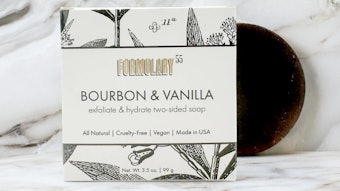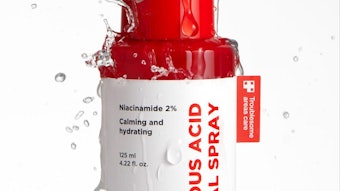
"Dehydrated skin" is a concern I come across in the clinic frequently. The signs my clients complain of, associated with epidermal dehydration, are feelings of tightness and discomfort that go hand in hand with a dull, ashy skin appearance. Dehydration can also stimulate excess oil production and make the facial skin feel patchy. Having reviewed the key principles of moisturizing technologies1 and the advances in mapping of facial skin hydration,2 the topic of skin hydration remains one of the most important in skin biology.
Increased hydration should be regarded as an essential performance parameter for any effective skin care product. Stratum corneum (SC) hydration state has a profound influence on skin biomechanical properties, bulk rheology, turgor and topography; increased hydration promotes a smoother surface with fewer wrinkles. Hydration also optimizes the activity of desquamatory enzymes, which contributes to further incremental smoothing of SC surface topography.3
Dehydrated skin can be caused by multiple environmental factors. Signs of dehydration tend to fluctuate depending on climate and season, or even lifestyle activities, such as swimming or using a sauna frequently. Quite often it is also the result of using harsh or irritating ingredients, or it can be due to the inappropriate use of too many skin care products at once in a combination that a specific skin type cannot tolerate (e.g., alpha hydroxy acids in combination with high concentrations of ascorbic acid, retinol derivatives, ethanol and mechanical exfoliators). This response can be highly individual, so I encourage my clients to pay attention to their skin feel and adjust their skin care routines accordingly.
However, it is not only combinations of active ingredients that can present problems. Even single formulations containing highly effective retinol and its derivatives, which deliver a variety of dermatological benefits, have trade-offs to skin health, including irritation, dryness, peeling and erythema.
Retinol-induced irritation (2 %) manifests as mild erythema and peeling of the SC. Pro-inflammatory cytokines (MCP-1 and IL-8) have been reported to mediate “retinol-induced dermatitis.” The changes in mRNA expression of these cytokines were observed in animal models. Clinically these cytokines represent good markers of retinol-induced irritation for anti-irritant screening.4
Nowadays, randomized double-blind vehicle-controlled, split-face studies are carried out to demonstrate the efficacy of skin care products. In terms of improving clinical endpoints associated with photo-aged facial skin, skin hydration is one of the most important factors.
The increase in SC hydration is measured by an increase in capacitance; a concurrent improvement in SC barrier function inferred by a reduction in trans-epidermal water loss (TEWL) is expected to confirm better-hydrated skin. However, all objective instrumental measurements have to be validated by blinded live visual grading for the consumer to appreciate the skin improvement.
Facial skin is always exposed and seasonally affected. It shows much poorer functional properties of the SC in the dry and cold winter months compared to the warm and humid summer months. Mild sub-clinical inflammation, as well as the efficacy of a moisturizer in alleviating its clinical symptoms, has been described previously in a key study conducted on facial skin in Japanese participants.
The objective parameters of that study included reduced skin surface hydration (measured by high-frequency conductance TEWL, and the skin surface lipid levels on the cheeks. Obtaining the SC from the skin surface by adhesive tape, interleukin (IL) 1alpha, IL-1 receptor antagonist (IL-1ra) and the cornified envelope (CE) maturation were determined. Moisturizing the face significantly increased the conductance values representing skin hydration and lowered TEWL, accompanied by a decreasing IL-1ra/IL-1alpha ratio and presence of immature CEs. The study confirmed the efficacy of the daily moisturization for improving mild subclinical inflammation induced by the winter environment.5
Using a novel facial mapping approach beyond the single point measurement of skin hydration highlights the immense complexity of facial skin hydration. It also enables the evaluation of the effect of facial moisturizers in different facial areas. Clearly visible maps have shown remarkable capacitance gradients within short distances at selected areas of the face; these gradients are distinctive in different ethnic groups.
Overall, the moisturizer tested showed higher efficacy for Africans compared to Caucasian and Indian skin. Poor hydration around the nasolabial fold has been followed by the most pronounced moisturizing effect in this area after the four-week treatment in all three ethnicities.6
As many as 70% of women can be affected with dryness on their faces, feeling discomfort, such as prickling and tight and pulling sensations. Research has shown that current skin care products do not completely meet consumer needs for moisturization. Modern moisturizing technologies bring about an improvement in skin hydration but also SC barrier function, skin topography, biomechanical properties and corresponding clinical appearance.
REFERENCES
1. http://www.cosmeticsandtoiletries.com/formulating/function/moisturizer/premium-Adapting-Formulas-to-Skin-Moisture-Needs-A-Review-209584151.html
2. https://www.cosmeticsandtoiletries.com/formulas-products/skin-care/article/21835417/advancements-in-facial-mapping-of-skin-biophysical-parameters
3. http://www.ncbi.nlm.nih.gov/pubmed/25940759
4. http://www.ncbi.nlm.nih.gov/pubmed/14615068
5. http://www.ncbi.nlm.nih.gov/pubmed/14571069
6. Voegeli, R. et al. Facial color mapping of stratum corneum hydration of different ethnic groups and the effect of a moisturizer; 23rd IFSCC Conference, 2015, Zurich
!['[W]e can predict better ingredients, faster, with our best-in-class models that we have invested in over several years,' says Joshua Britton, Ph.D., founder and CEO of Debut.](https://img.cosmeticsandtoiletries.com/mindful/allured/workspaces/default/uploads/2025/08/debut-biotechnology.c4slA2p7t3.jpg?auto=format%2Ccompress&fit=crop&h=191&q=70&w=340)








